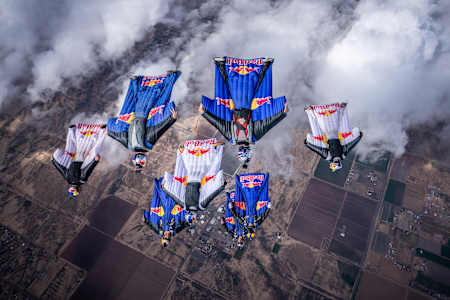
Wingsuit Flying
Wingsuit flying is the most dangerous extreme sport in the world, and with the invention of the wingsuit, skydiving has been revolutionised. Here you can find out how a wingsuit works!
From Icarus in Greek mythology to Leonardo da Vinci's machines, the idea of flying like a bird has always captivated people's wildest dreams. Today, thanks to the wingsuit, this dream has become a reality. The wingsuit seemingly defies the laws of nature and has become one of the most popular and thrilling disciplines in extreme sports in recent years. The sport requires perfect body control and balance, providing the ultimate adrenaline rush. The goal is to soar into the sky and fly like a bird (or jet) at speeds exceeding 200 km/h.
But how did wingsuits come to be, how are they used, and above all, how do they work? Lets fly in!
01
What is wingsuit flying?
Wingsuit flying is the most extreme air sport in the world. It is said that one must have completed at least 500 skydiving jumps before donning a wingsuit. Simply put, wingsuit flying is a form of skydiving.
02
The history of the wingsuit.
The history of the wingsuit dates back to the early 20th century. One of the earliest flight experiments in history took place in 1912, when Franz Reichelt, a French tailor, unsuccessfully attempted to jump from the Eiffel Tower with a parachute-wing combination he had developed.
The first wingsuit was born in 1930, and since then, several dozen different models have appeared. However, they all had one thing in common: they were extremely dangerous and claimed many lives. In 1990, French skydiver Patrick de Gayardon developed a new membrane-wing suit that was safer.
The first commercial wingsuit was developed by Finn Jari Kuosma and Croatian Robert Pečnik, marking the actual birth of the sport. The two were also responsible for a training program and launched a campaign to change the image of wingsuit flying.
03
How does a wingsuit work?
To practice wingsuit flying, two fundamental elements are required: a wingsuit and a parachute.
The purpose of the wingsuit is to convert vertical freefall into horizontal flight, while the parachute at the end of the jump is used to land safely on the ground. There are many different designs, but they all follow a set of principles. The jumpsuit is made of nylon (or another durable material) and has three wings: two between the arms and torso, and one between the legs.
The principle behind the function of a wingsuit is based on the generation of lift and the conversion of vertical fall into horizontal movement. The wingsuit's shape and design allow it to create a significant amount of lift, which slows down the descent and converts it into a horizontal gliding motion. The wingsuit pilot can control the direction and speed of the flight by changing the angle and shape of the wingsuit. However, it is important to note that a wingsuit does not provide enough lift to enable the wearer to fly upward like an airplane. Instead, it enables the wearer to glide through the air horizontally at high speeds. The parachute is still required to land safely on the ground.
Jump analysis with a wingsuit.
04
The jump-off
What are the three possibilities for the type of takeoff location in wingsuit jumping?
- From a fixed object: such as a mountain or a building.
- From an aircraft: airplanes, hot air balloons, or helicopters.
- BASE jumping: buildings, bridges or similar structures.
Depending on the jump location, the pilot must apply different techniques from the moment of the jump, which must be mastered to perfection.
05
The Flight
The function of the suit is to maximize the total surface area of the body in order to increase resistance against the vertical fall and enable greater horizontal displacement. Wingsuit flying requires precise coordination skills of the entire body, from the back and shoulders to the hips and arms. Experienced wingsuit pilots are able to move up to 3 meters horizontally for every vertical meter.
06
The Landing
After a proper dose of adrenaline, every wingsuit flight comes to an end. As one can imagine, it requires one more element, as a wingsuit is difficult to slow down. Therefore, a pilot needs to deploy a parachute towards the end of the jump. After that, the pilot glides to the ground in a leisurely manner.
Wingsuit flying is a risky discipline in which safety, weather, and planning play a crucial role.
07
The Planning
One of the most important steps in wingsuit flying is preparation. Wingsuit flying is a high-risk discipline in which safety, weather, and planning play a crucial role.
Spanish wingsuit pilot Dani Román always sketches before his jumps. "Drawing everything gives me confidence. Knowing the exact height, the horizontal distance, the time I need to open the parachute - these are the most important factors to safely perform a jump," he says. "The drawings are a simple way to depict everything graphically."
08
Wingsuit Records
As with all extreme sports, whether in the air, on land, or in water, one of the most enticing things for athletes is to be the best. And in wingsuit flying, there are already countless records. Here are some of the most spectacular:
- Highest jump (BASE-jump): 7,700 meters. It was set on October 5, 2016 by Russian Valery Rozov on Mount Cho Oyu, on the border between Nepal and Tibet.
- The longest flight: Jhonathan Flórez from Colombia flew with his wingsuit for 9 minutes and 6 seconds before opening his parachute. The record was set on April 20, 2012 in La Guajira, Colombia.
- Highest speed: British wingsuit pilot Fraser Corsan reached a speed of 400 km/h, the highest speed ever achieved by a human being without mechanical assistance. To be exact, he reached 396.88 km/h during a jump that did not comply with FAI rules.
- Längste Strecke: This record is held by American Kyle Lobpries. During his flight, he flew a total distance of 32,094 meters.
- Smallest target (BASE jump): American Pat Walker hit a 2.88-meter piece of fabric placed 4.5 meters above the ground.
- Record flight: Dani Román reached a speed of almost 300 km/h with his wingsuit and flew under the Puente Nuevo bridge in Ronda, Spain. Impressive record!














